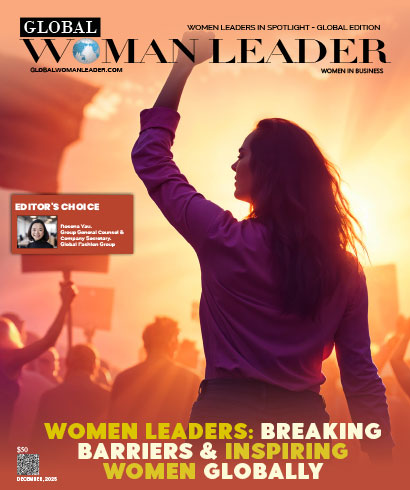Ashwini Balasubramanian is a head of Motorcycle Development Strategy & Operations at Harley-Davidson. A seasoned automotive leader, she drives strategic growth, champions gender equity, and is recognized internationally for her ESG advocacy and transformative leadership across engineering and operations.
In an engaging interaction with Global Woman Leader Magazine, Ashwini shares her insights on the key challenges facing the automotive industry today and how diverse leadership addresses them. Highlighting initiatives undertaken by alliances such as AWAF, Ashwini explains how it is advancing gender equity and breaking systemic barriers.
She also touches upon key themes such as overcoming cultural biases, importance of mentoring, shifting ESG goals, and more.
What challenges does the automotive industry today, and how can leadership tackle them more effectively?
The auto industry stands at a pivotal crossroads, uncertain whether electrification, hybrids, or alternative fuels will dominate the powertrain landscape. Supply chain volatility only adds to the pressure in an already unforgiving industry. No one has a crystal ball, but it is my humble opinion that the customer will ultimately drive the industry. The path forward demands resilience and reinvention.
Navigating these challenges requires leadership teams that reflect a wide range of experiences, technical, cultural, and generational, to anticipate risks and innovate across functions. This will be impossible to generate if you cripple your organization with group think.
The strategies that brought us this far won’t carry us forward.
We need new thinking, and that starts with diverse voices at the table. Companies that recognize this will position them for sustainable success.
How are organizations like the Automotive Women’s Alliance Foundation (AWAF) making real impact in driving gender equity across technical and leadership roles?
AWAF’s mission is to “Empower and Advance every woman in automotive and related industries.” Our industry has some systemic challenges; significant gaps remain in retaining women and advancing them into executive leadership roles. AWAF’s strategic focus in 2025 is to “Expand our reach”. We are expanding our signature programs like Scholarship, Coaching, Mentoring, STEM pipeline building to ensure women have the support they need in all phases of their careers. We have awarded academic scholarships to 274 women, totaling $704,500 as of June 2025.
We are also focused on increasing visibility of the female talent pool through enhanced marketing efforts (e.g., social media campaigns, industry partnerships, speaker platforms). We’ve expanded our programming with virtual events to increase accessibility and broaden our geographic reach. By expanding our reach and amplifying women’s voices, AWAF is helping shape a more inclusive and innovative future for the automotive industry.
In your experience, what cultural or systemic barriers still prevent women from rising in automotive careers? How can industry-wide alliances work to dismantle them?
There are intrinsic and extrinsic barriers that prevent them from maximizing their potential in their careers. For over a decade, many initiatives have focused on equipping women with leadership skills such as strategic confidence, assertive communication, and business acumen. This is crucial as it helps women get prepared for key leadership roles. But there has not been enough focus on dismantling some of the extrinsic implicit barriers women face about still carrying the primary caregiving load at home, the persistent belief that authoritative leadership styles are the most effective.
In addition to preparing women for leadership roles, it would be great to see Industry-wide alliances can play a pivotal role by advocating for flexible work policies, challenging outdated leadership norms, and holding organizations accountable for equitable promotion practices.
How has women’s involvement in sustainability and innovation changed the way companies approach ESG goals in automotive manufacturing and design?
Sustainability in automotive is often narrowly equated with tailpipe emissions. While environmental impact is critical, ESG also encompasses social and governance dimensions, areas where women’s leadership is making a transformative difference.
Women influence over 50% of vehicle purchasing decisions yet have historically been underrepresented in the industry. Closing that gap isn’t just about equity, it’s about aligning our workforce with the consumers we serve. When women are involved in innovation and sustainability, companies gain a more holistic understanding of customer needs, leading to products that are intuitive, inclusive, and future-ready.
This shift is changing how companies approach ESG: from compliance-driven checklists to purpose-driven strategies that reflect the values and expectations of a diverse customer base.
LAST WORD: Supporting More Women In Engineering & Strategy Roles
Supporting Women in Engineering and strategy roles require more than recruitment, it demands a culture that enables growth, values outcomes, and reflects the diversity of the customers we serve. First, organizations must build equitable systems: flexible work policies, outcome-based performance reviews, and gender-neutral job descriptions help create a level playing field. Bias recognition training is also essential to ensure fairness in decision-making.
Equally important is investing in people. Mentors and advocates play a critical role in encouraging women to take on stretch roles that build new capabilities. Managers should be trained to pair performance feedback with clear, actionable development plans, so growth isn’t left to chance. Ultimately, it’s about creating an environment where women don’t just enter the field, they thrive, lead, and shape the future of the industry.
🍪 Do you like Cookies?
We use cookies to ensure you get the best experience on our website. Read more...
Copyright © All rights reserved. Global Woman Leader

.png)
